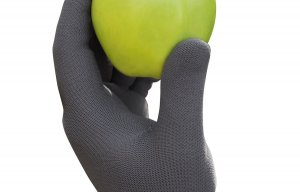
Hofler launches antibacterial and antiviral glove
The research team has been working together to develop a glove in which the heating elements are actually integrated into the knitted structure of the glove.

26th January 2015
Innovation in Textiles
|
Nottingham
Nottingham Trent University’s Advanced Textile Research Team, led by Professor Tilak Dias, together with medical consultant and Raynaud’s research specialist Dr Marina Anderson, has used cutting-edge flat knitting technology to develop gloves that can help alleviate the pain caused by Raynaud’s phenomenon.
Raynaud’s is a debilitating condition, affecting 5-10% of the general population, which causes interruption of the blood supply to the extremities, such as the fingers and hands, making them feel extremely cold, turn white and triggering intense pain.
Heated gloves have shown to help alleviate the pain but tend to be cumbersome, uncomfortable and often impractical because bulky heated elements are sewn into the gloves, the University reports.
The research team has been working together to develop a glove in which the heating elements are actually integrated into the knitted structure of the glove using advanced flat knitting technology, allowing them to be extremely thin and practical.
The technology employed means that the gloves are flexible enough to allow the wearer to operate a mobile phone or cashpoint and handle small change – all activities, which are difficult or even impossible with current products available, according to the University. The gloves are also said to be fully washable and have an appealing look.
“Now is the time to introduce state-of-the-art, fully textile-based heating zones where the fibres themselves provide the heat in a controlled manner,” said Professor Dias.
“Development of reliable heated gloves that are lightweight, thin, flexible, washable, easy to put on due to the inherent stretch, allow excellent dexterity and grip, incorporate only a small lightweight battery with excellent battery life and are aesthetically pleasing will empower people to manage their Raynaud’s phenomenon at home.”
The project has received £128,182 of funding over two years from the Raynaud’s and Scleroderma Association, which will allow the team at Nottingham Trent University to work with patients attending Dr Anderson’s Raynaud’s clinic at Aintree University Hospital, Liverpool, to design the gloves according to wearers’ needs.
By working with design groups, which will include those patients at the clinic with the condition, the researchers will have a better understanding of where heater zones should be placed within the gloves to promote the best blood flow to the fingers. The team will then produce a range of gloves with heater zones of different sizes and locations to be trialled by the group.
Liz Bevins, CEO, from the Raynaud’s and Scleroderma Association, said: “We are delighted to support this project at NTU, with Dr Anderson and the dedicated research team. Raynaud’s sufferers frequently have issues in keeping their hands warm and having a battery operated, external heat source that is compact, lightweight and user friendly, means we are confident it will bring a great level of comfort and relief to those with daily challenges.”

Business intelligence for the fibre, textiles and apparel industries: technologies, innovations, markets, investments, trade policy, sourcing, strategy...
Find out more